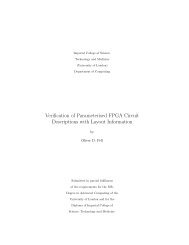A Survey of Monte Carlo Tree Search Methods - Department of ...
A Survey of Monte Carlo Tree Search Methods - Department of ...
A Survey of Monte Carlo Tree Search Methods - Department of ...
Create successful ePaper yourself
Turn your PDF publications into a flip-book with our unique Google optimized e-Paper software.
IEEE TRANSACTIONS ON COMPUTATIONAL INTELLIGENCE AND AI IN GAMES, VOL. 4, NO. 1, MARCH 2012 10<br />
Fig. 3. Asymmetric tree growth [68].<br />
any moment in time; allowing the algorithm to run for<br />
additional iterations <strong>of</strong>ten improves the result.<br />
It is possible to approximate an anytime version <strong>of</strong><br />
minimax using iterative deepening. However, the granularity<br />
<strong>of</strong> progress is much coarser as an entire ply is<br />
added to the tree on each iteration.<br />
3.4.3 Asymmetric<br />
The tree selection allows the algorithm to favour more<br />
promising nodes (without allowing the selection probability<br />
<strong>of</strong> the other nodes to converge to zero), leading<br />
to an asymmetric tree over time. In other words, the<br />
building <strong>of</strong> the partial tree is skewed towards more<br />
promising and thus more important regions. Figure 3<br />
from [68] shows asymmetric tree growth using the BAST<br />
variation <strong>of</strong> MCTS (4.2).<br />
The tree shape that emerges can even be used to gain a<br />
better understanding about the game itself. For instance,<br />
Williams [231] demonstrates that shape analysis applied<br />
to trees generated during UCT search can be used to<br />
distinguish between playable and unplayable games.<br />
3.5 Comparison with Other Algorithms<br />
When faced with a problem, the a priori choice between<br />
MCTS and minimax may be difficult. If the game tree<br />
is <strong>of</strong> nontrivial size and no reliable heuristic exists for<br />
the game <strong>of</strong> interest, minimax is unsuitable but MCTS<br />
is applicable (3.4.1). If domain-specific knowledge is<br />
readily available, on the other hand, both algorithms<br />
may be viable approaches.<br />
However, as pointed out by Ramanujan et al. [164],<br />
MCTS approaches to games such as Chess are not as<br />
successful as for games such as Go. They consider a<br />
class <strong>of</strong> synthetic spaces in which UCT significantly<br />
outperforms minimax. In particular, the model produces<br />
bounded trees where there is exactly one optimal action<br />
per state; sub-optimal choices are penalised with a fixed<br />
additive cost. The systematic construction <strong>of</strong> the tree<br />
ensures that the true minimax values are known. 12 In<br />
this domain, UCT clearly outperforms minimax and the<br />
gap in performance increases with tree depth.<br />
Ramanujan et al. [162] argue that UCT performs<br />
poorly in domains with many trap states (states that lead<br />
to losses within a small number <strong>of</strong> moves), whereas iterative<br />
deepening minimax performs relatively well. Trap<br />
states are common in Chess but relatively uncommon<br />
in Go, which may go some way towards explaining the<br />
algorithms’ relative performance in those games.<br />
3.6 Terminology<br />
The terms MCTS and UCT are used in a variety <strong>of</strong><br />
ways in the literature, sometimes inconsistently, potentially<br />
leading to confusion regarding the specifics <strong>of</strong> the<br />
algorithm referred to. For the remainder <strong>of</strong> this survey,<br />
we adhere to the following meanings:<br />
• Flat <strong>Monte</strong> <strong>Carlo</strong>: A <strong>Monte</strong> <strong>Carlo</strong> method with<br />
uniform move selection and no tree growth.<br />
• Flat UCB: A <strong>Monte</strong> <strong>Carlo</strong> method with bandit-based<br />
move selection (2.4) but no tree growth.<br />
• MCTS: A <strong>Monte</strong> <strong>Carlo</strong> method that builds a tree to<br />
inform its policy online.<br />
• UCT: MCTS with any UCB tree selection policy.<br />
• Plain UCT: MCTS with UCB1 as proposed by Kocsis<br />
and Szepesvári [119], [120].<br />
In other words, “plain UCT” refers to the specific algorithm<br />
proposed by Kocsis and Szepesvári, whereas the<br />
other terms refer more broadly to families <strong>of</strong> algorithms.<br />
4 VARIATIONS<br />
Traditional game AI research focusses on zero-sum<br />
games with two players, alternating turns, discrete action<br />
spaces, deterministic state transitions and perfect<br />
information. While MCTS has been applied extensively<br />
to such games, it has also been applied to other domain<br />
types such as single-player games and planning problems,<br />
multi-player games, real-time games, and games<br />
with uncertainty or simultaneous moves. This section<br />
describes the ways in which MCTS has been adapted<br />
to these domains, in addition to algorithms that adopt<br />
ideas from MCTS without adhering strictly to its outline.<br />
4.1 Flat UCB<br />
Coquelin and Munos [68] propose flat UCB which effectively<br />
treats the leaves <strong>of</strong> the search tree as a single multiarmed<br />
bandit problem. This is distinct from flat <strong>Monte</strong><br />
<strong>Carlo</strong> search (2.3) in which the actions for a given state<br />
are uniformly sampled and no tree is built. Coquelin<br />
and Munos [68] demonstrate that flat UCB retains the<br />
adaptivity <strong>of</strong> standard UCT while improving its regret<br />
bounds in certain worst cases where UCT is overly<br />
optimistic.<br />
12. This is related to P-game trees (7.3).















